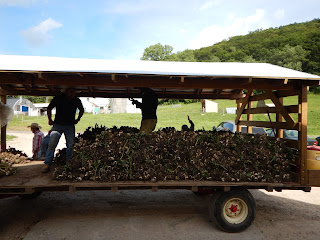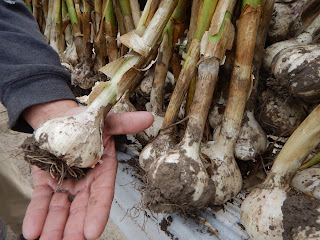 A little over a week ago, Monday, July 4th to be exact, we finished harvesting the 2016 garlic crop. We got it in just in time—it started raining within 30 minutes of closing the greenhouse door where it is stored. Every garlic crop is a labor of love and despite the number of harvests I’ve been through, every crop meets me with a feeling of anxiousness around harvest time. I can’t rest until it’s all in, safe and sound. Learning how to grow garlic is a skill and an art I’ve learned over many years. My lessons in garlic go back to the mid 70’s when I first started farming…..and tried to learn how to grow garlic from old Dave Frattalone. Here’s the story.
A little over a week ago, Monday, July 4th to be exact, we finished harvesting the 2016 garlic crop. We got it in just in time—it started raining within 30 minutes of closing the greenhouse door where it is stored. Every garlic crop is a labor of love and despite the number of harvests I’ve been through, every crop meets me with a feeling of anxiousness around harvest time. I can’t rest until it’s all in, safe and sound. Learning how to grow garlic is a skill and an art I’ve learned over many years. My lessons in garlic go back to the mid 70’s when I first started farming…..and tried to learn how to grow garlic from old Dave Frattalone. Here’s the story.I started my farming career at my first farm, Blue Gentian, in St. Paul, Minnesota. There were several old-timers I learned a lot from in those early days of farming. Henry Hildebrandt & Dave Frattalone were two farmers who were in their 70’s and 80’s about the time I started farming. Their families had a long history of growing vegetables for the people in the St. Paul area and sold their produce at the farmer’s markets. Henry’s family had a long history of being good tomato growers and had 2 acres of cold frames that they used to grow vegetables in during the off-season—they even pulled off radishes in March! Dave Frattalone was from a well-respected Italian family who had been supplying St. Paul for years. Both of these gentleman were instrumental in teaching me many important things about farming that you just can’t learn about in a text book, seed catalog or really in any way other than by doing it. So how do you get an old-timer to teach you things and share their knowledge? You offer to plow their fields! That tactic worked well with Henry who lived close to my farm. In exchange for my labor, we developed a good neighborly relationship that opened up many doors for me to learn about growing vegetables. Conversely, Dave lived further away in Little Canada and was a little harder to warm up to. In Atina Diffley’s book, Turn Here Sweet Corn, she describes Dave as “The King of the Saint Paul Farmers’ Market.” At that time, Dave was the only one at the market who grew and sold garlic. I was intrigued by Dave’s garlic and tried to talk to him about growing it. Unfortunately old Dave had no interest in talking to me about garlic. It was clear he did not want to teach anyone else how to grow this valuable crop, so he remained tight-lipped for several years!
 Let’s put the story into perspective. In the late 1800’s and early 1900’s farmers’ markets were thriving. It was the place people went to purchase their “groceries.” Food was produced and purchased within the region, so people relied on their local farmers to show up at the markets each week. The Frattalone and Hildebrandt families sold everything they could grow and left each market with an empty wagon. Well, let me rephrase that. They didn’t take vegetables home, but Henry’s family did have the contract to clean up all the horse manure after the market (remember there were still a lot of horses being used for transportation at this time). They’d bring their wagon to market loaded with vegetables, and would take it home loaded with rich, nutritious horse manure for their cold frames! In the same wagon--yikes! Unfortunately, times started to change and with the development of grocery stores and transcontinental transportation, people shifted their purchasing from the farmers’ markets to the grocery stores. By the time I entered the scene and started selling at the St. Paul farmer’s market, times were rough and a lot of farmers were taking large amounts of vegetables home with them each week instead of selling out. The competition was thick and old Dave was just protecting his livelihood and the “monopoly” he had on the local garlic market.
Let’s put the story into perspective. In the late 1800’s and early 1900’s farmers’ markets were thriving. It was the place people went to purchase their “groceries.” Food was produced and purchased within the region, so people relied on their local farmers to show up at the markets each week. The Frattalone and Hildebrandt families sold everything they could grow and left each market with an empty wagon. Well, let me rephrase that. They didn’t take vegetables home, but Henry’s family did have the contract to clean up all the horse manure after the market (remember there were still a lot of horses being used for transportation at this time). They’d bring their wagon to market loaded with vegetables, and would take it home loaded with rich, nutritious horse manure for their cold frames! In the same wagon--yikes! Unfortunately, times started to change and with the development of grocery stores and transcontinental transportation, people shifted their purchasing from the farmers’ markets to the grocery stores. By the time I entered the scene and started selling at the St. Paul farmer’s market, times were rough and a lot of farmers were taking large amounts of vegetables home with them each week instead of selling out. The competition was thick and old Dave was just protecting his livelihood and the “monopoly” he had on the local garlic market.Well, I still wanted to learn how to grow garlic, even if Dave wasn’t willing to help me. At that time I did know Dave was buying garlic from an old seed company in California, Basic Vegetable. He grew a softneck variety that he planted in the spring and produced small bulbs that he harvested in the fall. Knowing little more than that about garlic, I had to do my own research. I started reading and found a farmer in Canada who grew a different type of garlic, a hardneck variety. He produced beautiful garlic, but one of the keys to his success was planting it in the fall. I started experimenting with growing garlic and quickly learned some key lessons, including the importance of careful seed selection. Since seed garlic wasn’t as readily available as it is today, I learned how to save “seed” from each year’s garlic crop to replant. After several years of experimenting with growing garlic, I took one of my nicest bulbs of garlic over to Dave Frattalone. When he saw the quality and size of my garlic, he perked up in interest and was all ears. I willingly shared with him everything I had learned about garlic and on that day I broke through to old Dave. After that experience, Dave was much more willing to share his farming knowledge with me, knowing I’d do the same for him.
 To this day I still value the lessons I learned from these old-timers. Maybe old Dave’s greatest contribution to my farming education was that he did not tell me his secrets to growing garlic! If I had not been forced to seek out information on my own, I may never have found the Canadian grower who introduced me to the hardneck garlic we grow and rely on today. In fact, our Porcelain garlic originated from seed garlic I got from him! We’ve carefully maintained this variety and have saved seed from it for over 30 years now! Thanks, Dave and Henry, for sharing your farming knowledge and experiences with me. It is true that you reap what you sow…in garlic and in relationships.
To this day I still value the lessons I learned from these old-timers. Maybe old Dave’s greatest contribution to my farming education was that he did not tell me his secrets to growing garlic! If I had not been forced to seek out information on my own, I may never have found the Canadian grower who introduced me to the hardneck garlic we grow and rely on today. In fact, our Porcelain garlic originated from seed garlic I got from him! We’ve carefully maintained this variety and have saved seed from it for over 30 years now! Thanks, Dave and Henry, for sharing your farming knowledge and experiences with me. It is true that you reap what you sow…in garlic and in relationships.
No comments:
Post a Comment